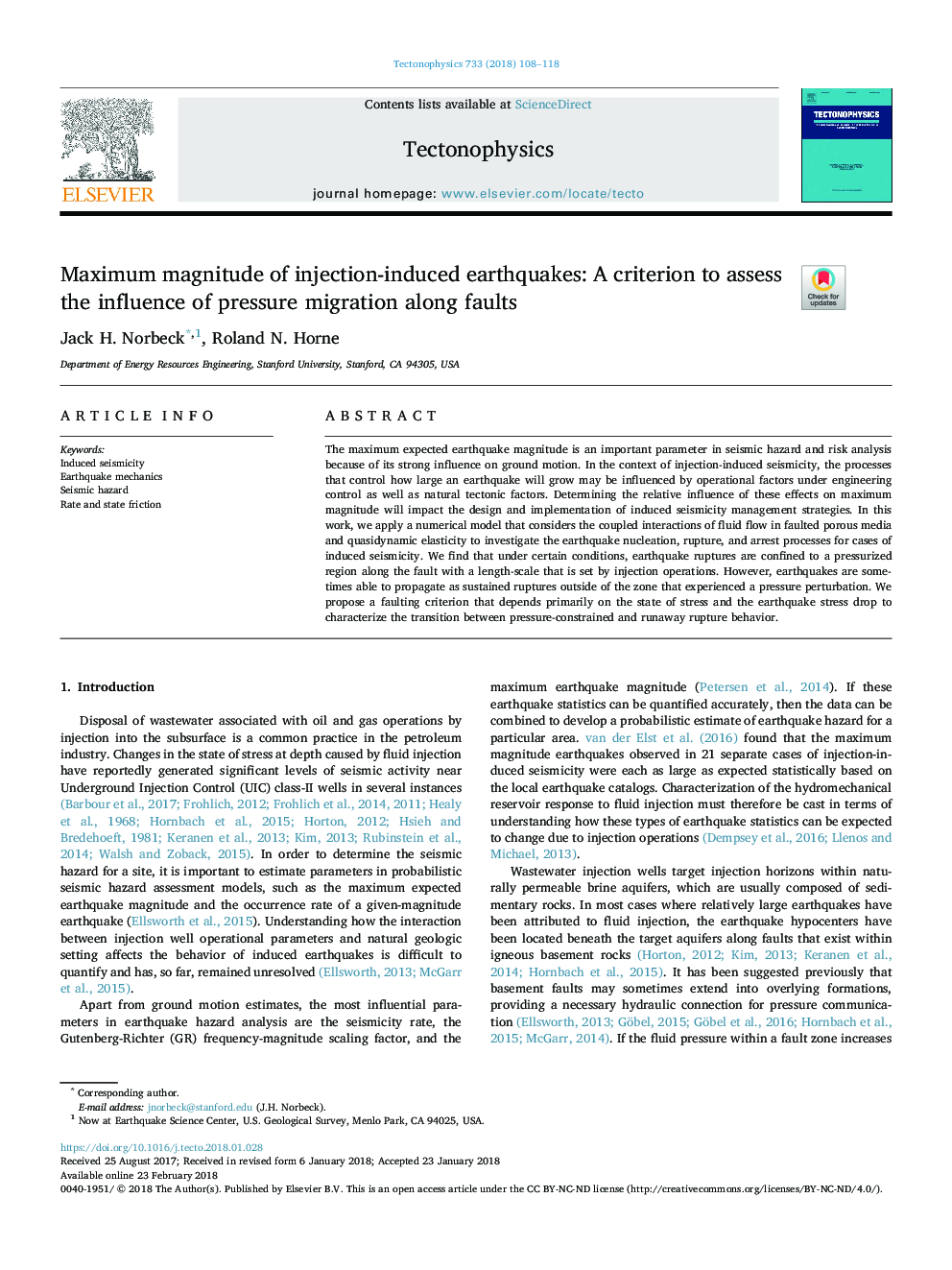| کد مقاله | کد نشریه | سال انتشار | مقاله انگلیسی | نسخه تمام متن |
|---|---|---|---|---|
| 8908692 | 1636679 | 2018 | 11 صفحه PDF | دانلود رایگان |
عنوان انگلیسی مقاله ISI
Maximum magnitude of injection-induced earthquakes: A criterion to assess the influence of pressure migration along faults
ترجمه فارسی عنوان
حداکثر مقدار زمین لرزه های ناشی از تزریق: یک معیار برای ارزیابی تاثیر مهاجرت فشار در امتداد گسل ها
دانلود مقاله + سفارش ترجمه
دانلود مقاله ISI انگلیسی
رایگان برای ایرانیان
کلمات کلیدی
ترجمه چکیده
حداکثر مقدار زلزله احتمالی مهمی در خطر زلزله و تجزیه و تحلیل خطر است به دلیل تاثیر شدید آن در حرکت زمین. در زمینه لرزه نگاری ناشی از تزریق، فرایندهایی که کنترل زلزله بزرگ را افزایش می دهند، می توانند تحت تأثیر عوامل عملیاتی تحت کنترل مهندسی و همچنین عوامل زمین شناسی طبیعی قرار گیرند. تعیین تأثیر نسبی این تأثیرات بر حداکثر اندازه، بر طراحی و اجرای استراتژی های مدیریت زلزله القا شده تاثیر خواهد گذاشت. در این کار، ما یک مدل عددی را در نظر می گیریم که تعاملات متقابل جریان سیال در رسانه های متخلخل متخلخل و کشش کوادینامیک را برای بررسی فوران های هسته ای، پارگی، و دست زدن زمین لرزه برای موارد لرزه خیزی ناشی می کند. ما دریافتیم که در شرایط خاص، شکستگی زلزله محدود به یک ناحیه تحت فشار در امتداد خطا با مقیاس طولی است که توسط عملیات تزریق تعیین می شود. با این حال، زمین لرزه ها گاهی اوقات می توانند به عنوان شکست های مداوم در خارج از منطقه که تحریک فشار را تجربه کرده اند، پخش شود. ما یک معیار گسستی را پیشنهاد می کنیم که عمدتا بستگی به وضعیت تنش و افت استرس زلزله دارد تا مشخص شود انتقال بین رفتار پارگی تحت فشار و فرار.
موضوعات مرتبط
مهندسی و علوم پایه
علوم زمین و سیارات
فرآیندهای سطح زمین
چکیده انگلیسی
The maximum expected earthquake magnitude is an important parameter in seismic hazard and risk analysis because of its strong influence on ground motion. In the context of injection-induced seismicity, the processes that control how large an earthquake will grow may be influenced by operational factors under engineering control as well as natural tectonic factors. Determining the relative influence of these effects on maximum magnitude will impact the design and implementation of induced seismicity management strategies. In this work, we apply a numerical model that considers the coupled interactions of fluid flow in faulted porous media and quasidynamic elasticity to investigate the earthquake nucleation, rupture, and arrest processes for cases of induced seismicity. We find that under certain conditions, earthquake ruptures are confined to a pressurized region along the fault with a length-scale that is set by injection operations. However, earthquakes are sometimes able to propagate as sustained ruptures outside of the zone that experienced a pressure perturbation. We propose a faulting criterion that depends primarily on the state of stress and the earthquake stress drop to characterize the transition between pressure-constrained and runaway rupture behavior.
ناشر
Database: Elsevier - ScienceDirect (ساینس دایرکت)
Journal: Tectonophysics - Volume 733, 9 May 2018, Pages 108-118
Journal: Tectonophysics - Volume 733, 9 May 2018, Pages 108-118
نویسندگان
Jack H. Norbeck, Roland N. Horne,
